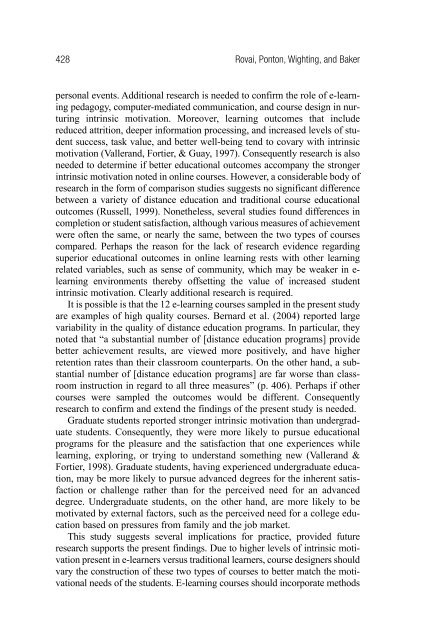A Comparative Analysis of Student Motivation in ... - Anitacrawley.net
A Comparative Analysis of Student Motivation in ... - Anitacrawley.net
A Comparative Analysis of Student Motivation in ... - Anitacrawley.net
You also want an ePaper? Increase the reach of your titles
YUMPU automatically turns print PDFs into web optimized ePapers that Google loves.
428 Rovai, Ponton, Wight<strong>in</strong>g, and Bakerpersonal events. Additional research is needed to confirm the role <strong>of</strong> e-learn<strong>in</strong>gpedagogy, computer-mediated communication, and course design <strong>in</strong> nurtur<strong>in</strong>g<strong>in</strong>tr<strong>in</strong>sic motivation. Moreover, learn<strong>in</strong>g outcomes that <strong>in</strong>cludereduced attrition, deeper <strong>in</strong>formation process<strong>in</strong>g, and <strong>in</strong>creased levels <strong>of</strong> studentsuccess, task value, and better well-be<strong>in</strong>g tend to covary with <strong>in</strong>tr<strong>in</strong>sicmotivation (Vallerand, Fortier, & Guay, 1997). Consequently research is alsoneeded to determ<strong>in</strong>e if better educational outcomes accompany the stronger<strong>in</strong>tr<strong>in</strong>sic motivation noted <strong>in</strong> onl<strong>in</strong>e courses. However, a considerable body <strong>of</strong>research <strong>in</strong> the form <strong>of</strong> comparison studies suggests no significant differencebetween a variety <strong>of</strong> distance education and traditional course educationaloutcomes (Russell, 1999). No<strong>net</strong>heless, several studies found differences <strong>in</strong>completion or student satisfaction, although various measures <strong>of</strong> achievementwere <strong>of</strong>ten the same, or nearly the same, between the two types <strong>of</strong> coursescompared. Perhaps the reason for the lack <strong>of</strong> research evidence regard<strong>in</strong>gsuperior educational outcomes <strong>in</strong> onl<strong>in</strong>e learn<strong>in</strong>g rests with other learn<strong>in</strong>grelated variables, such as sense <strong>of</strong> community, which may be weaker <strong>in</strong> e-learn<strong>in</strong>g environments thereby <strong>of</strong>fsett<strong>in</strong>g the value <strong>of</strong> <strong>in</strong>creased student<strong>in</strong>tr<strong>in</strong>sic motivation. Clearly additional research is required.It is possible is that the 12 e-learn<strong>in</strong>g courses sampled <strong>in</strong> the present studyare examples <strong>of</strong> high quality courses. Bernard et al. (2004) reported largevariability <strong>in</strong> the quality <strong>of</strong> distance education programs. In particular, theynoted that “a substantial number <strong>of</strong> [distance education programs] providebetter achievement results, are viewed more positively, and have higherretention rates than their classroom counterparts. On the other hand, a substantialnumber <strong>of</strong> [distance education programs] are far worse than classroom<strong>in</strong>struction <strong>in</strong> regard to all three measures” (p. 406). Perhaps if othercourses were sampled the outcomes would be different. Consequentlyresearch to confirm and extend the f<strong>in</strong>d<strong>in</strong>gs <strong>of</strong> the present study is needed.Graduate students reported stronger <strong>in</strong>tr<strong>in</strong>sic motivation than undergraduatestudents. Consequently, they were more likely to pursue educationalprograms for the pleasure and the satisfaction that one experiences whilelearn<strong>in</strong>g, explor<strong>in</strong>g, or try<strong>in</strong>g to understand someth<strong>in</strong>g new (Vallerand &Fortier, 1998). Graduate students, hav<strong>in</strong>g experienced undergraduate education,may be more likely to pursue advanced degrees for the <strong>in</strong>herent satisfactionor challenge rather than for the perceived need for an advanceddegree. Undergraduate students, on the other hand, are more likely to bemotivated by external factors, such as the perceived need for a college educationbased on pressures from family and the job market.This study suggests several implications for practice, provided futureresearch supports the present f<strong>in</strong>d<strong>in</strong>gs. Due to higher levels <strong>of</strong> <strong>in</strong>tr<strong>in</strong>sic motivationpresent <strong>in</strong> e-learners versus traditional learners, course designers shouldvary the construction <strong>of</strong> these two types <strong>of</strong> courses to better match the motivationalneeds <strong>of</strong> the students. E-learn<strong>in</strong>g courses should <strong>in</strong>corporate methods
















